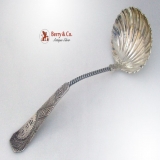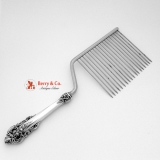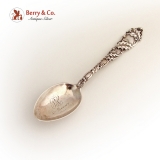Archived Products
Cigar Lamp and Stand Rosette Sterling Silver Tiffany and Co 1870

code: wb114
American sterling silver cigar lamp and stand made by Tiffany & Company, c.1870- 1874. This unusual lamp has openwork rosette handles attached to an urn form body and is screwed to a circular dish shaped stand with an inner band of die rolled decoration. The original gilding inside the stand shows light wear. Monogrammed A.E.W.P., in ornate, period script under the rim of the stand, the excellent original condition, with no removals, repairs or alterations make this a very desirable piece of Antique Tiffany silver. Dimensions: Height 4 ½†Diameter 4 ½†Weight 6.6 ozs Troy Maker & Marks: Tiffany & Company New York City C.1870 – 1874 TIFFANY&Co; 2678 ;STERLING
Sold
Noah′s Ark Sterling Baby Cup Gorham 1900

code: SHCM016
Sold
Gyllenberg Art and Crafts Bowl 1925

code: SHAC001
Sold
Schofield Ribbed Cup No Monogram 1920

code: BC003
Sold
Falick Novick Arts and Crafts Serving Bowl 1935

code: SHBL020
Sold
Falick Novick Arts and Crafts Serving Bowl 1935

code: SHBL021
Sold
Falick Novick Creamer Sugar Bowl Spoon 1925

code: SHCS002
Sold
Falick Novick Creamer Sugar Bowl Spoon 1925

code: wb17
American sterling silver Arts & Crafts hand hammered hand made creamer, sugar bowl and matching sugar spoon, all having an applied “T†monogram. The set is in excellent original condition, with a wonderful finish and no repairs or alterations. Novick is an extremely desirable Chicago Silversmith whose work seldom comes on the market. The best book on Chicago silver is Sharon S. Darling′s Chicago Silversmiths, published in 1977 as a catalog of an exhibition by the Chicago Historical Society. Darling mentions dozens of silversmiths who worked in Chicago, but several stand out. One is Falick Novick, who came to America from Russia in 1893 at the age of 15, and was initially employed as a plumber′s assistant. In 1907, he moved to Chicago to work as a silversmith, but struggled for years. Novick produced copper bowls for the Kalo Shop until 1920, when it stopped selling copper items, and the heavy silver trays for which he is best known. He eventually prospered and sold his work through retail outlets such as Macy′s until he died in 1957. Novick′s mark was usually STERLING / HANDWROUGHT / BY / F. NOVICK / CHICAGO, although the city was sometimes omitted. His work, and that of Heinrich Eicher, are on a par with Kalo’s. Dimensions: Creamer: weight 7.6 ozs. Troy, height 3 ¾â€, length 5 ¾†Sugar bowl: weight 7.6 ozs. Troy, height 3 ¾â€, length across the handles 6 ¼†Sugar spoon: weight 1.2 ozs. Troy, length 6†Maker: Falick Novick Chicago Illinois. Marked: Sterling Handwrought by F. Novick Chicago. C.1925-1935.
Sold
Baltimore Rose Gravy Boat and Under Plate 1905

code: wb612
Sold
Coin 950 Silver Presentation Coffee Pot 1856

code: wb617
American sterling 950 silver presentation coffee pot with allover engine turned decorations, die rolled bands of decorations, a pomegranate filial and a fancy C scroll handle with ivory insulators. Inscribed: Presented to Geo Gault by his late partners, Loomis Bullard, H. B. Shute, the pot is in excellent original condition, with no repairs or alterations. It sits on a spread foot, circular pedestal base. We call this a coin silver pot, as it was made in the coin silver period of American silver production, even though the silver content is 950/100, as per the requirements of Ball Black & Co, the New York City, retailers of this wonderful piece. This coffee pot was made by the firm of Eaton, Gordon and Bogert. More about them below. In 1856 William Bogert left Forbes and moved to Newburgh, where he joined William R. Eaton and John Gordon (his father and brothers former apprentice and the husband of his niece Sarah) in the partnership of Eaton, Gordon, and Bogert, silversmiths. Their wares, marked "E G & B," were largely supplied to the retail jewelers Ball, Black and Company (successor in 1851 to Ball, Tompkins and Black) in New York City. In 1860 Eaton retired from the partnership, which became Gordon and Bogert (with the mark "G & B"). That firm is listed in the 1860 Federal census of the products of industry as makers of silverware with nine male employees and $3,800 in capital, annually utilizing forty-five hundred ounces of coin-standard silver (900/1000) and an equal amount of pure silver (999/1000). Interestingly, the average fineness of their silver, 950/1000, was the standard required by Ball, Black and Company for their silverware from the late 1850s to the early 1860s, suggesting that a great proportion, if not all, of Gordon and Bogert′s production was for Ball, Black and Company Surviving examples suggest that the bulk of it was hollow ware. Dimensions: Height 11†Width from spout to the handle 11†Weight 32 ozs Troy
Sold
Wallace Carmel Bread Tray 1915

code: wb618
American sterling silver bread tray in the Carmel pattern by Wallace Silversmiths, Wallingford Connecticut, c.1915. The strap work and hammering on the body and tab handle show excellent detail. There is a fancy, period monogram “W†in the center of the tray. Excellent condition, with no repairs or alterations. Dimensions: Weight 10 ozs. Troy, Length 12â€, Width 6 ¾â€, Height 1 ¼†Maker: Wallace Silversmiths, Wallingford, Connecticut. c.1915. R W deer head & S mark; Sterling; 1856
Sold
Shreve Fourteenth Century Plate 1915

code: BPL001
Sold
Towle Old English Serving Bowl 1892

code: SHBL029
Sold
Shreve Fourteenth Century Cup 1915

code: wb540
Sold
Kalo Serving Bowl New York Chicago Mark 1918

code: SHBL014
Sold
Watsoncraft Fruit Bowl Hammered 1930

code: SHBL017
Sold
Kalo Five Pannelled Bowl 1920

code: SHBL019
Sold
Randahl Basket Early Mark 1920

code: SHBL027
Sold
Randahl Basket Early Mark 1920

code: wb18
Sold
Whiting Christmas 1899 Floral Repousse Cup

code: SHCM007
Sold
Shreve Plate

code: SHP001
Sold
Repousse Flower Scissors

code: SHS002
Sold
Islamic Silver Vase

code: SHV005
Sold
Aesthetic Soup Ladle Bright Cut Twist Handle Sterling Silver Caldwell 1870 No Mono

code: f1223
American sterling silver soup ladle with shell bowl and bright cut engraved and twisted handle by J E Caldwell, c.1870.
This beautiful ladle is 9 7/8" long and weighs 103 grams or 3.3 ozs troy.
Monogrammed MCT in a period script.
The soft, warm, original finish is present, with no buffing or machine polishing.
The excellent original condition and clear, crisp detail, with no monograms, removals, repairs or alterations, make this an especially attractive offering.
Sold
Mustard ladle William Durgin Egg Bowl Coin Silver 1850 Monogram LMM

code: f1515
American coin silver mustard ladle in fiddle tipt pattern by William B. Durgin of Concord New Hampshire, with an egg shaped bowl and having a period script monogram on the back of the handle: LMM.
Weighing 8 grams the delicate and desirable ladle is 5 1/2" long.
Monogrammed as described above, the soft, warm, original finish is present, with no buffing or machine polishing.
The excellent original condition and clear detail, with no removals, repairs or alterations, make this an especially attractive offering.
Sold
Pie Server Sterling Silver Erickson

code: f2859
American sterling silver pie server by G.Erickson
This handsome server is 8 1/4'' long and weighs 63 grams or 2.1 ozs Troy.
The excellent original condition and clear, crisp detail, with no removals repairs or alterations, make this an especially attractive offering.
Monogrammed as described above, the soft, warm, original antique finish is present, with no buffing or machine polishing.
Sold
Buttercup Baby Set Sterling Silver Gorham 1899

code: f3189
American sterling silver baby set consisting of spoon and a fork in the Buttercup pattern by Gorham Silversmiths, 1899.
This set is 4 1/2'' long and weighs 48 grams or 1.6 ozs Troy.
The soft, warm, original finish is present, with no buffing or machine polishing.
The excellent original condition and clear detail, with no removals, repairs or alterations, make this an especially attractive offering.
Sold
Victorian Sugar Sifter England Sterling Silver 1881

code: f3796
English sterling silver sugar sifter with Asian motif bright cut decorations in the bowl and the handle, with a full set of Hallmarks for Birmingham, 1881, by Hilliard&Thomason.
This beautiful sifter is 5 3/16" long and weighs 22 grams.
The soft, warm, original finish is present, with no buffing or machine polishing.
Sold
Grande Baroque Cake Breaker Sterling Silver Handle Plated Blade Wallace 1941

code: f4049
American sterling silver handled cake breaker with a plated blade in the Grand Baroque pattern by Wallace Silversmiths, 1941.
This especially attractive and useful cake breaker is 11 1/4" long.
The soft, warm, original finish is present, with no buffing or machine polishing.
The excellent original condition and clear, crisp detail, with no monograms, removals, repairs or alterations, make this an especially attractive offering. (f4049a)
Sold
Holly Teaspoon Alvin Sterling Silver

code: f4188
American sterling silver teaspoon in the Holly pattern by Alvin Silver Co. Monogrammed "BC Dec."
This handsome spoon is 5 1/2" long and weighs 22 grams or 0.7 Ozs Troy.
The soft, warm, original finish is present, with no buffing or machine polishing.
The excellent estate original condition and clear, crisp detail, with no removals, repairs or alterations, make this an especially attractive offering.
Sold

